Certified Motorcycle Helmets: Computational Evaluation of the Efficacy of Standard Requirements with Finite Element Models
Abstract
1. Introduction
2. Materials and Methods
2.1. Motorcycle Helmet Model
2.1.1. Numerical Modeling
2.1.2. Material Modeling
| is the pressure; | |
| is the von Mises stress; | |
| is the deviatoric stress and I is the identity matrix; | |
| is the size of the (vertical) q-axis of the yield ellipse; | |
| is the size of the (horizontal) p-axis of the yield ellipse; | |
| is the shape factor of the yield ellipse; | |
| is the center of the yield ellipse on the p-axis; | |
| is the yield stress in hydrostatic compression (always positive); | |
| is the strength of the material in hydrostatic tension. |
2.1.3. Acceleration Curves
2.2. Injury Risk Evaluation
YEAHM
3. Results
3.1. Impact Point B
3.2. Impact Point P
3.3. Impact Point R
3.4. Impact Point X
4. Discussion and Conclusions
Author Contributions
Funding
Acknowledgments
Conflicts of Interest
References
- World Health Organization. Global Status Report on Road Safety. 2018. Available online: https://www.who.int/violence_injury_prevention/road_safety_status/2018/en/ (accessed on 13 February 2020).
- EPSR. Road Fatality Statistics in the EU (Infographic). Available online: https://www.europarl.europa.eu/news/en/headlines/society/20190410STO36615/road-fatality-statistics-in-the-eu-infographic (accessed on 13 February 2020).
- United Nations. ECE Regulation 22.05—Uniform Provision Concerning the Approval of Protective Helmets and Their Visors for Driver and Passengers of Motor Cycles and Mopeds. Available online: www.unece.org/fileadmin/DAM/trans/main/wp29/wp29regs/r022r4e.pdf (accessed on 13 February 2020).
- Fernandes, F.A.O.; Alves de Sousa, R.J. Head injury predictors in sports trauma—A state-of-the-art review. J. Eng. Med. 2015, 229, 592–608. [Google Scholar] [CrossRef] [PubMed]
- Bellora, A.; Krauss, R.; van Poolen, L. Meeting Interior Head Impact Requirements: A Basic Scientific Approach. SAE Trans. 2001, 110, 383–408. [Google Scholar]
- Kleiven, S. Influence of Impact Direction to the Human Head in Prediction of Subdural Hematoma. J. Neurotrauma 2003, 20, 365–379. [Google Scholar] [CrossRef] [PubMed]
- Kleiven, S. Influence of direction and duration of impacts to the human head evaluated using the finite element method. In Proceedings of the IRCOBI Conference, Prague, Czech Republic, 21–23 September 2005; pp. 41–57. [Google Scholar]
- Feist, F.; Gugler, J.; Arregui-Dalmases, C.; del Pozo de Dios, E.; Lopez-Valdes, F.; Deck, D.; Willinger, R. Pedestrian collisions with flat-fronted vehicles: Injury patterns and importance of rotational accelerators as a predictor for traumatic brain injury (TBI). In Proceedings of the 21st International Conference on the Enhanced Safety of Vehicles, Stuttgart, Germany, 15–18 June 2009; pp. 1–19. [Google Scholar]
- Fenner, H., Jr.; Thomas, D.J.; Gennarelli, T.; Pintar, F.A.; Becker, E.B.; Newman, J.A.; Yoganandan, N. Final Report of Workshop on Criteria for Head Injury and Helmet Standards; Department of Neurosurgery, Medical College of Wisconsin: Milwaukee, WI, USA, 2005. [Google Scholar]
- Kim, G.H.; Lee, O.S.; Yoo, S.S. Experimental study on impact absorbing performance of motorcycle helmets. KSME Int. J. 1997, 11, 292–299. [Google Scholar] [CrossRef]
- Kleiven, S.; von Holst, H. Consequences of head size following trauma to the human head. J. Biomech. 2002, 35, 153–160. [Google Scholar] [CrossRef]
- Newman, J.A. Head injury criteria in automotive crash testing. SAE Tech. Pap. 1980. [Google Scholar] [CrossRef]
- Newman, J. On the Use of the Head Injury Criterion (HIC) in Protective Headgear Evaluation. SAE Tech. Pap. 1975. [Google Scholar] [CrossRef]
- Johnson, G.I. Investigations on impact testing of head injury protection helmets. Int. J. Crashworthiness 2000, 5, 491–502. [Google Scholar] [CrossRef]
- Zhao, W.; Ji, S. Brain strain uncertainty due to shape variation in and simplification of head angular velocity profiles. Biomech. Model. Mechanobiol. 2017, 16, 449–461. [Google Scholar] [CrossRef]
- Aare, M.; Kleiven, S.; Halldin, P. Injury tolerances for oblique impact helmet testing. Int. J. Crashworthiness 2004, 9, 15–23. [Google Scholar] [CrossRef]
- King, A.; Yang, K.; Zhang, L.; Hardy, W.; Viano, D. Is head injury caused by linear or angular acceleration? In Proceedings of the IRCOBI Conference, Lisbon, Portugal, 25–26 September 2003; pp. 1–10. [Google Scholar]
- Gennarelli, T.A. Head injury in man and experimental animals: Clinical aspects. Acta Neurochir. Suppl. 1983, 32, 1–13. [Google Scholar] [PubMed]
- Margulies, S.S.; Thibault, L.E. A proposed tolerance criterion for diffuse axonal injury in man. J. Biomech. 1992, 25, 917–923. [Google Scholar] [CrossRef]
- Newman, J. The biomechanics of head trauma and the development of the modern helmet. How far have we really come? In Proceedings of the IRCOBI Conference, Prague, Czech Republic, 21–23 September 2005. [Google Scholar]
- Pratellesi, A.; Turrin, S.; Haag, T.; Scippa, A.; Baldanzini, N. On the effect of testing uncertainties in the homologation tests of motorcycle helmets according to ECE 22.05. Int. J. Crashworthiness 2011, 16, 523–536. [Google Scholar] [CrossRef]
- Shuaeib, F.M.; Hamouda, A.M.S.; Radin Umar, R.S.; Hamdan, M.M.; Hasmi, M.S.J. Motorcycle helmet part I. Biomechanics and computational issues. J. Mater. Process. Technol. 2002, 123, 406–421. [Google Scholar] [CrossRef]
- Tinard, V.; Deck, C.; Willinger, R. New methodology for improvement of helmet performance during impacts with regards to biomechanical criteria. Mater. Des. 2012, 37, 79–88. [Google Scholar] [CrossRef]
- Fernandes, F.A.O.; Alves de Sousa, R.J.; Willinger, W.; Deck, C. Finite Element Analysis of Helmeted Impacts and Head Injury Evaluation with a Commercial Road Helmet. In Proceedings of the IRCOBI Conference, Gothenburg, Sweden, 11–13 September 2013; pp. 431–442. [Google Scholar]
- Schmitt, K.U.; Niederer, P.F.; Cronin, D.S.; Morrison, B., III; Muser, M.H.; Walz, F. Head Injuries. In Trauma Biomechanics; Springer: Cham, Switzerland, 2019. [Google Scholar]
- Aare, M.; Kleiven, S.; Halldin, P. Injury criteria for oblique helmet impacts. In Proceedings of the IRCOBI Conference, Lisbon, Portugal, 25–26 September 2003; pp. 349–350. [Google Scholar]
- Deck, C.; Baumgartner, B.; Willinger, R. Helmet Optimisation on head-helmet modelling. Struct. Mater. 2003, 13, 319–328. [Google Scholar]
- Forero Rueda, M.A.; Cui, L.; Gilchrist, M.D. Optimisation of energy absorbing liner for equestrian helmets. Part I: Layered foam liner. Mater. Des. 2009, 30, 3405–3413. [Google Scholar] [CrossRef]
- Kleiven, S. A parametric study of energy absorbing foams for head injury prevention. In Proceedings of the 20th International Technical Conference on the Enhanced Safety of Vehicles Conference, Lyon, France, 18–21 June 2007. [Google Scholar]
- Prasartthong, N.; Koetniyom, S.; Carmai, J. Development of Motorcycle Helmet for Pre-school Children Using Metal Foam. In Proceedings of the 9th Thai Society of Mechanical Engineers, International Conference on Mechanical Engineering, Phuket, Thailand, 11–14 December 2018. [Google Scholar]
- Han, Y.; He, W.; Shi, L.; Wu, H.; Pan, D.; Huang, H. Helmet protective performance via reconstruction of electric two-wheeler rider’s head-to-ground impact accidents. Int. J. Crashworthiness 2019. [Google Scholar] [CrossRef]
- Hynčík, L.; Bońkowski, T.; Lv, W. Development of a simple motorcyclist helmet finite element model. Int. J. Veh. Saf. 2018, 10, 277–287. [Google Scholar] [CrossRef]
- Fernandes, F.A.O.; Alves de Sousa, R.J. Finite element analysis of helmeted oblique impacts and head injury evaluation with a commercial road helmet. Struct. Eng. Mech. 2013, 48, 661–679. [Google Scholar] [CrossRef]
- Fernandes, F.A.O.; Alves de Sousa, R.J.; Ptak, M.; Migueis, G. Helmet Design Based on the Optimization of Biocomposite Energy-Absorbing Liners under Multi-Impact Loading. Appl. Sci. 2019, 9, 735. [Google Scholar] [CrossRef]
- Cui, L.; Forero Rueda, M.A.; Gilchrist, M.D. Optimisation of energy absorbing liner for equestrian helmets. Part II: Functionally graded foam liner. Mater. Des. 2009, 30, 3414–3419. [Google Scholar] [CrossRef]
- Mills, N.J.; Gilchrist, A. Motorcycle helmet shell optimisation. In Proceedings of the Association for Advancement of Automotive Medicine Conference, Portland, OR, USA, 5–7 October 1992; pp. 149–162. [Google Scholar]
- Pinnoji, P.K.; Mahajan, P. Impact analysis of helmets for improved ventilation with deformable head model. In Proceedings of the IRCOBI Conference, Madrid, Spain, 14–16 September 2006; pp. 159–170. [Google Scholar]
- Pinnoji, P.K.; Haider, Z.; Mahajan, P. Design of motorcycle helmets: Computational fluid and impact dynamics studies. Int. J. Crashworthiness 2008, 13, 265–278. [Google Scholar] [CrossRef]
- Fernandes, F.A.O.; Tchepel, D.; Alves de Sousa, R.J.; Ptak, M. Development and validation of a new finite element human head model: Yet Another Head Model (YEAHM). Eng. Comput. 2018, 35, 447–496. [Google Scholar] [CrossRef]
- Horgan, T.J.; Gilchrist, M.D. The creation of three-dimensional finite element models for simulating head impact biomechanics. Int. J. Crashworthiness 2003, 8, 353–366. [Google Scholar] [CrossRef]
- Kleiven, S. Predictors for traumatic brain injuries evaluated through accident reconstructions. In Proceedings of the 51st Stapp Car Crash Conference, San Diego, CA, USA, 29–31 October 2007; pp. 81–114. [Google Scholar]
- Mao, H.; Zhang, L.; Jiang, B.; Genthikatti, V.V.; Jin, X.; Zhu, F.; Makwana, R.; Gill, A.; Jandir, G.; Singh, A.; et al. Development of a Finite Element Human Head Model Partially Validated with Thirty Five Experimental Cases. J. Biomech. Eng. 2013, 135, 111002. [Google Scholar] [CrossRef]
- Sahoo, D.; Deck, C.; Willinger, R. Brain injury tolerance limit based on computation of axonal strain. Accid. Anal. Prev. 2016, 92, 53–70. [Google Scholar] [CrossRef]
- Takhounts, E.G.; Ridella, S.A.; Hasija, V.; Tannous, R.E.; Campbell, J.Q.; Malone, D.; Danelson, K.; Stitzel, J.; Rowson, S.; Duma, S. Investigation of Traumatic Brain Injuries Using the Next Generation of Simulated Injury Monitor (SIMon) Finite Element Head Model. Stapp Car Crash J. 2008, 52, 1–31. [Google Scholar]
- Zhang, L.; Yang, K.H.; King, A.I. Comparison of brain responses between frontal and lateral impacts by finite element modelling. J. Neurotrauma 2001, 18, 21–30. [Google Scholar] [CrossRef]
- Khanuja, T.; Unni, H.N. Intracranial pressure-based validation and analysis of traumatic brain injury using a new three-dimensional finite element human head model. Proc. Inst. Mech. Eng. H 2020, 234, 3–15. [Google Scholar] [CrossRef]
- Saboori, P.; Walker, G. Brain Injury and Impact Characteristics. Ann. Biomed. Eng. 2019, 47, 1982–1992. [Google Scholar] [CrossRef] [PubMed]
- Giudice, J.S.; Zeng, W.; Wu, T.; Alshareef, A.; Shedd, D.F.; Panzer, M.B. An Analytical Review of the Numerical Methods Used for Finite Element Modeling of Traumatic Brain Injury. Ann. Biomed. Eng. 2019, 47, 1855–1872. [Google Scholar] [CrossRef] [PubMed]
- Yu, C.; Wang, F.; Wang, B.; Li, L.; Li, F. A Computational Biomechanics Human Body Model Coupling Finite Element and Multibody Segments for Assessment of Head/Brain Injuries in Car-To-Pedestrian Collisions. Int. J. Environ. Res. Public Health 2020, 17, 492. [Google Scholar] [CrossRef] [PubMed]
- Migueis, G.; Fernandes, F.A.O.; Ptak, M.; Ratajczak, M.; Alves de Sousa, R.J. Detection of bridging veins rupture and subdural haematoma onset using a finite element head model. Clin. Biomech. 2019, 63, 104–111. [Google Scholar] [CrossRef]
- Toma, M.; Nguyen, P.D.H. Coup-contrecoup brain injury: Fluid-structure interaction simulations. Int. J. Crashworthiness 2019. [Google Scholar] [CrossRef]
- Fernandes, F.A.O.; Alves de Sousa, R.J.; Ptak, M. Head Injury Simulation in Road Traffic Accidents; Springer International Publishing: Cham, Switzerland, 2018. [Google Scholar]
- Brands, D.W.A.; Thunnissen, J.G.M.; Wismans, J.S.H.M. Modelling head injury countermeasures: A 3D helmet model. In Proceedings of the AGARD Meeting on Impact Head Injury, Mescalero, NM, USA, 7–9 November 1996. [Google Scholar]
- Pinnoji, P.K.; Mahajan, P. Analysis of impact-induced damage and delamination in the composite shell of a helmet. Mater. Des. 2010, 31, 3716–3723. [Google Scholar] [CrossRef]
- Cernicchi, A.; Galvanetto, U.; Iannucci, L. Virtual modelling of safety helmets: Practical problems. Int. J. Crashworthiness 2008, 13, 451–467. [Google Scholar] [CrossRef]
- Tinard, V.; Deck, C.; Willinger, R. Modelling and validation of motorcyclist helmet with composite shell. Int. J. Crashworthiness 2012, 17, 209–215. [Google Scholar] [CrossRef]
- Shuaeib, F.M.; Hamouda, A.M.S.; Hamdan, M.M.; Radin Umar, R.S.; Hashmi, M.S.J. Motorcycle helmet: Part II, Materials and design issues. J. Mater. Process. Technol. 2002, 123, 422–431. [Google Scholar] [CrossRef]
- Vallée, H.; Hartemann, F.; Thomas, C.; Tarriére, C.; Patel, A.; Got, C. The fracturing of helmet shells. In Proceedings of the IRCOBI Conference, Delft, The Netherlands, 4–6 September 1984; pp. 99–109. [Google Scholar]
- Mills, N.J.; Wilkes, S.; Derler, S.; Flisch, A. FEA of oblique impact tests on a motorcycle helmet. Int. J. Impact Eng. 2009, 36, 913–925. [Google Scholar] [CrossRef]
- ABAQUS 6. 10 Documentation; Hibbitt, Karlsson & Sorensen, Inc.: New York, NY, USA, 2010. [Google Scholar]
- Fernandes, F.A.O.; Jardin, R.T.; Pereira, A.B.; Alves de Sousa, R.J. Comparing the mechanical performance of synthetic and natural cellular materials. Mater. Des. 2015, 82, 335–341. [Google Scholar] [CrossRef]
- Fernandes, F.A.O.; Alves de Sousa, R.J. Motorcycle helmets—A state-of-the-art review. Accid. Anal. Prev. 2013, 56, 1–21. [Google Scholar] [CrossRef] [PubMed]
- Mustafa, H.; Pang, T.Y.; Perret-Ellena, T.; Subic, A. Finite element bicycle helmet models development. Procedia Technol. 2015, 20, 91–97. [Google Scholar] [CrossRef][Green Version]
- Mordaka, J.; Kleiven, S.; van Schijndel de Nooij, M.; de Lange, R.; Casanova, L.J.G.; Carter, E.L.; von Holst, H. The importance of rotational kinematics in pedestrian head to windshield impacts. In Proceedings of the IRCOBI Conference, Maastricht, The Netherlands, 19–21 September 2007; pp. 83–94. [Google Scholar]
- Hardy, W.N.; Foster, C.D.; Mason, M.J.; King, K.H.; King, A.I.; Tashman, S. Investigation of head injury mechanisms using neutral density technology and high-speed biplanar X-ray. Stapp Car Crash J. 2001, 45, 337–368. [Google Scholar] [PubMed]
- Miller, K.; Chinzei, K. Mechanical properties of brain tissue in tension. J. Biomech. 2002, 35, 483–490. [Google Scholar] [CrossRef]
- Ogden, R.W. Large deformation isotropic elasticity-on the correlation of theory and experiment for incompressible rubber like solids. Proc. R. Soc. Lond. A Math. Phys. Sci. 1972, 326, 565–584. [Google Scholar]
- Rashid, B.; Destrade, M.; Gilchrist, M.D. Mechanical characterization of brain tissue in compression at dynamic strain rates. J. Mech. Behav. Biomed. Mater. 2012, 10, 23–38. [Google Scholar] [CrossRef]
- Rashid, B.; Destrade, M.; Gilchrist, M.D. Hyperelastic and viscoelastic properties of brain tissue in tension. In Proceedings of the ASME 2012 International Mechanical Engineering Congress & Exposition, Houston, TX, USA, 9–15 November 2012; pp. 9–15. [Google Scholar]
- Gilchrist, M.D. Modelling and Accident Reconstruction of Head Impact Injuries. Key Eng. Mater. 2003, 245, 417–432. [Google Scholar] [CrossRef]
- Nahum, A.M.; Smith, R.; Ward, C.C. Intracranial pressure dynamics during head impact. In Proceedings of the 21st Stapp Car Crash Conference, New Orleans, LA, USA, 19–21 October 1977; pp. 339–366. [Google Scholar]
- Wright, R.M.; Ramesh, K.T. An axonal strain injury criterion for traumatic brain injury. Biomech. Model. Mechanobiol. 2012, 11, 245–260. [Google Scholar] [CrossRef]
- Bain, B.C.; Meaney, D.F. Tissue-level thresholds for axonal damage in an experimental model of central nervous system white matter injury. J. Biomech. Eng. 2000, 122, 615–622. [Google Scholar] [CrossRef]
- Bandak, F.A.; Zhang, A.X.; Tannous, R.E.; DiMasi, F.; Masiello, P.; Eppinger, R. SIMon: A simulated injury monitor: Application to head injury assessment. In Proceedings of the 17th International Technical Conference on the Enhanced Safety of Vehicles, Amsterdam, The Netherlands, 4–7 June 2001. [Google Scholar]
- Zhang, L.; Yang, K.; King, A. A proposed injury threshold for mild traumatic brain injury. J. Biomech. Eng. 2004, 126, 226–236. [Google Scholar] [CrossRef] [PubMed]
- Marjoux, D.; Baumgartner, D.; Deck, C.; Willinger, R. Head injury prediction capability of the HIC, HIP, SIMon and ULP criteria. Accid. Anal. Prev. 2008, 40, 1135–1148. [Google Scholar] [CrossRef] [PubMed]
- Deck, C.; Willinger, R. Head injury prediction tool for predictive systems optimization. In Proceedings of the 7th European LS-DYNA Conference, Salzburg, Austria, 14–15 May 2009. [Google Scholar]
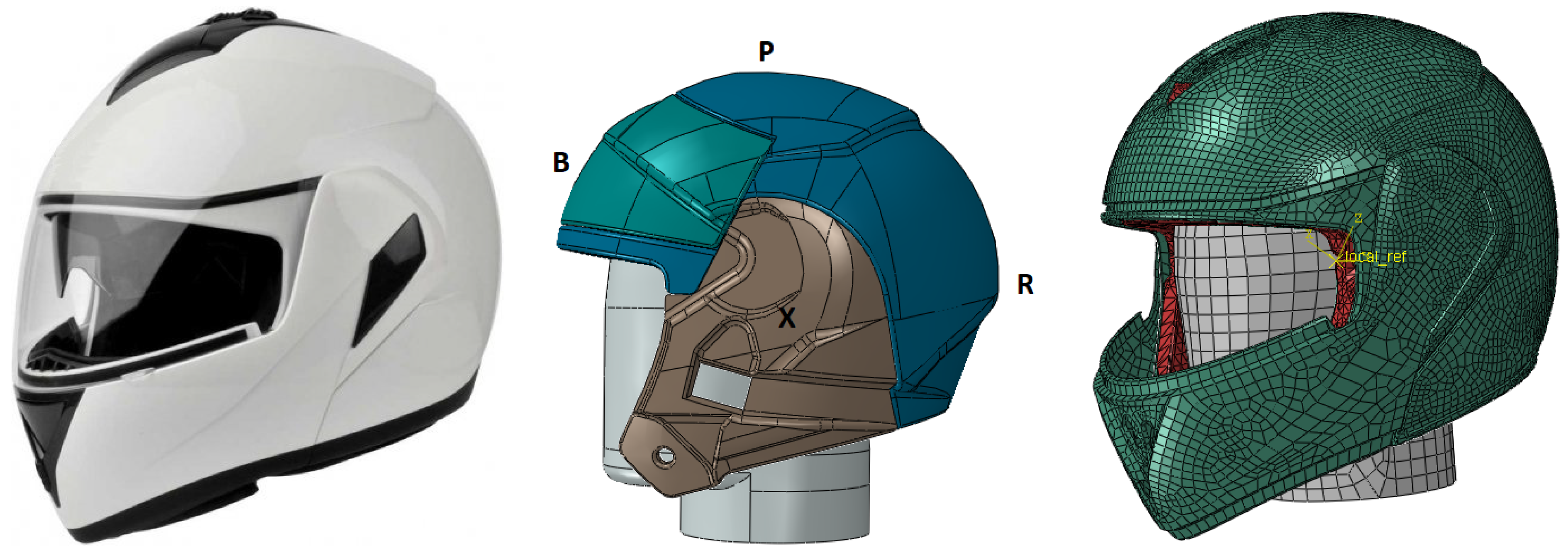
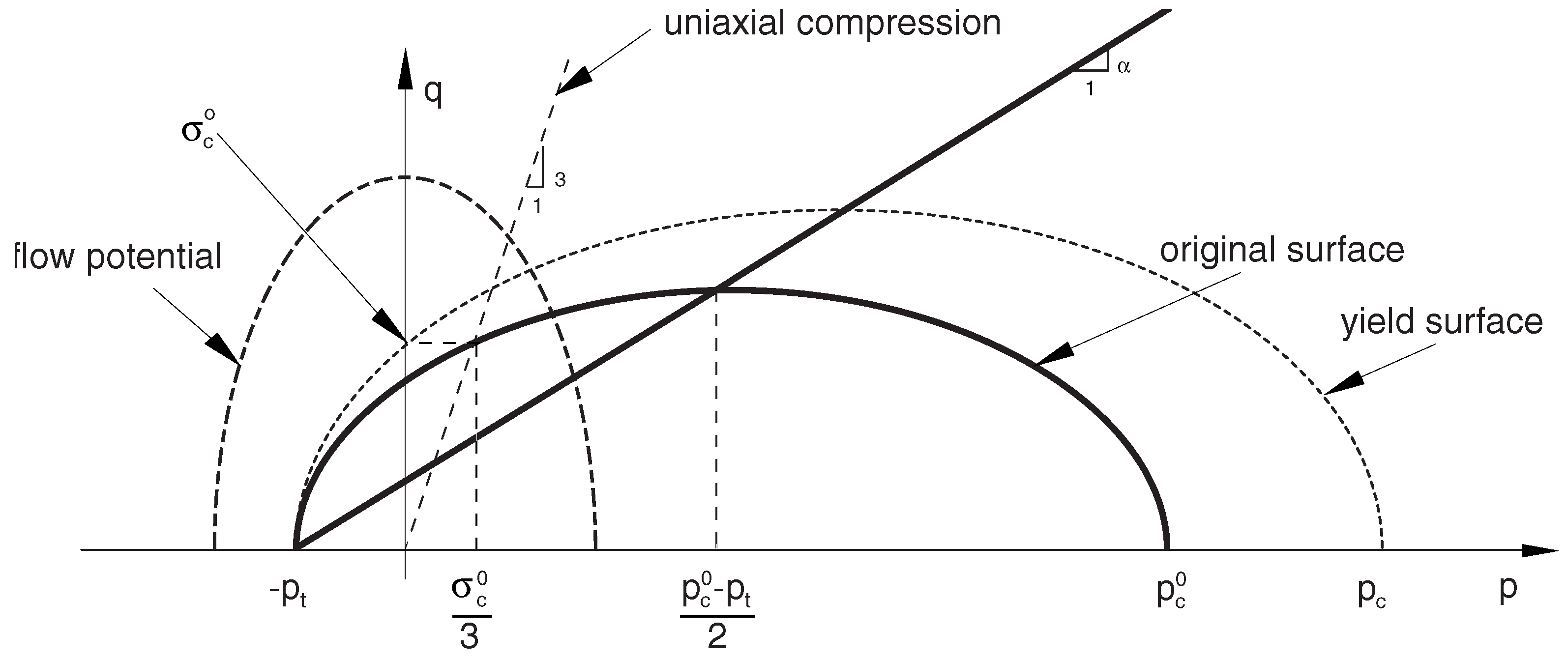
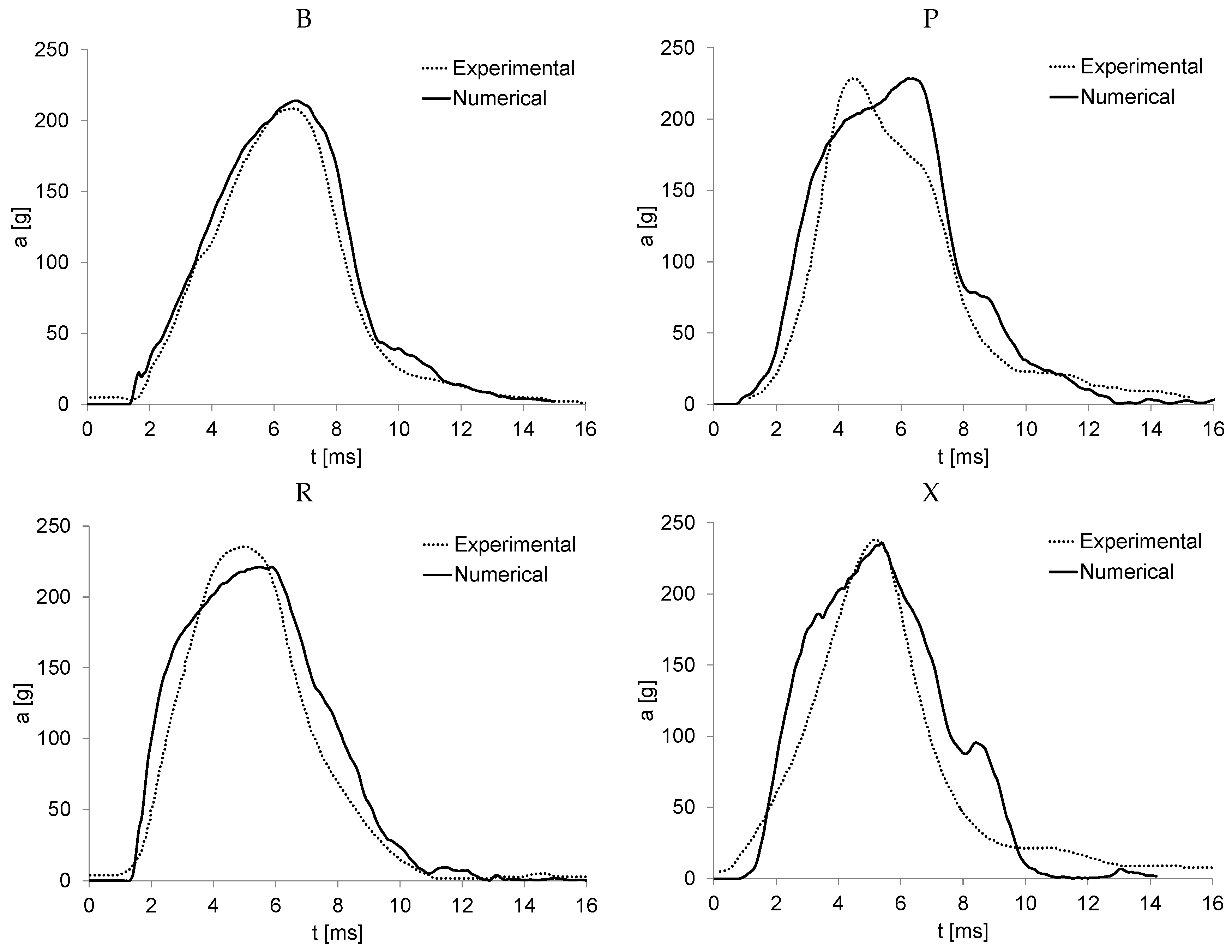

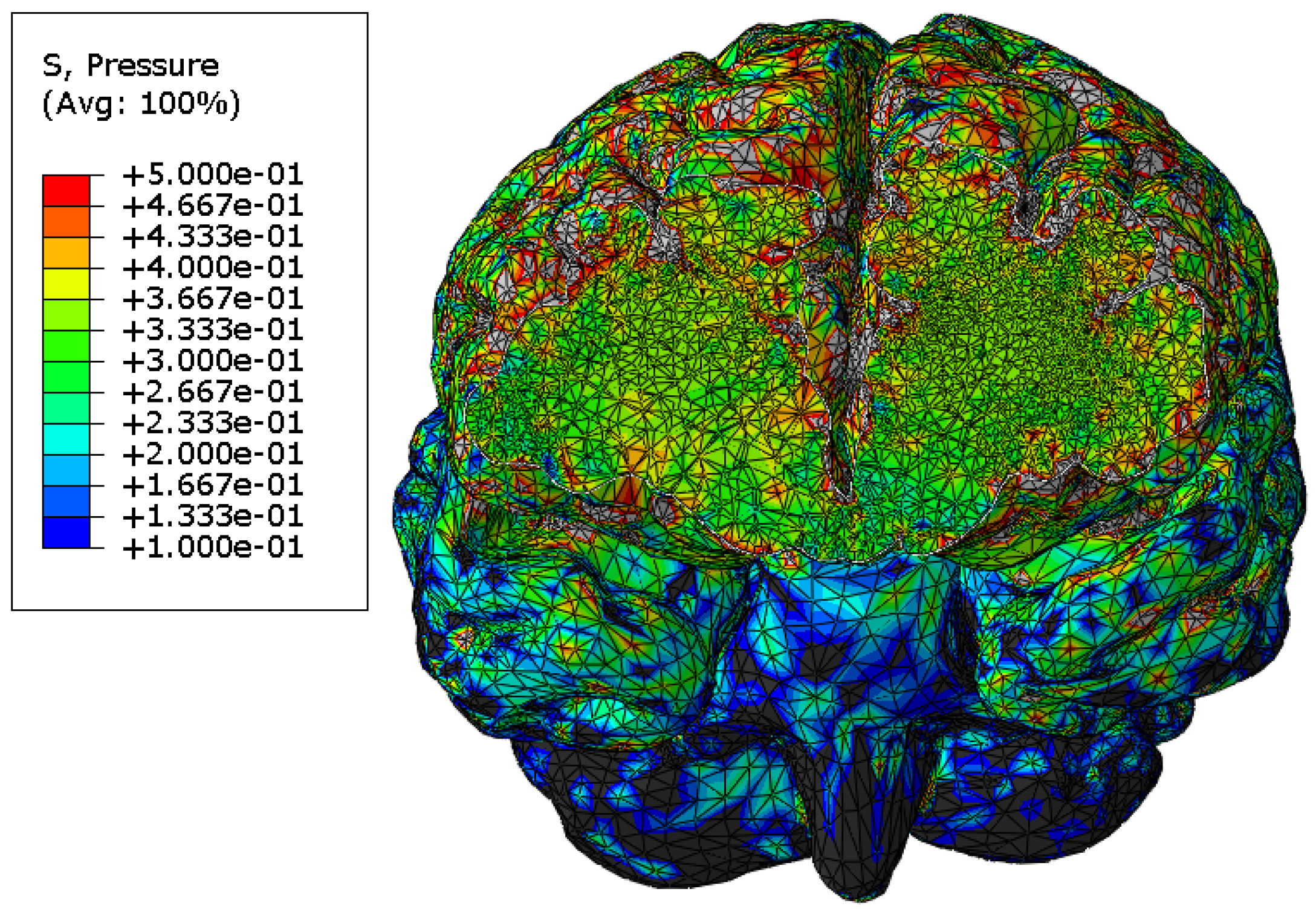
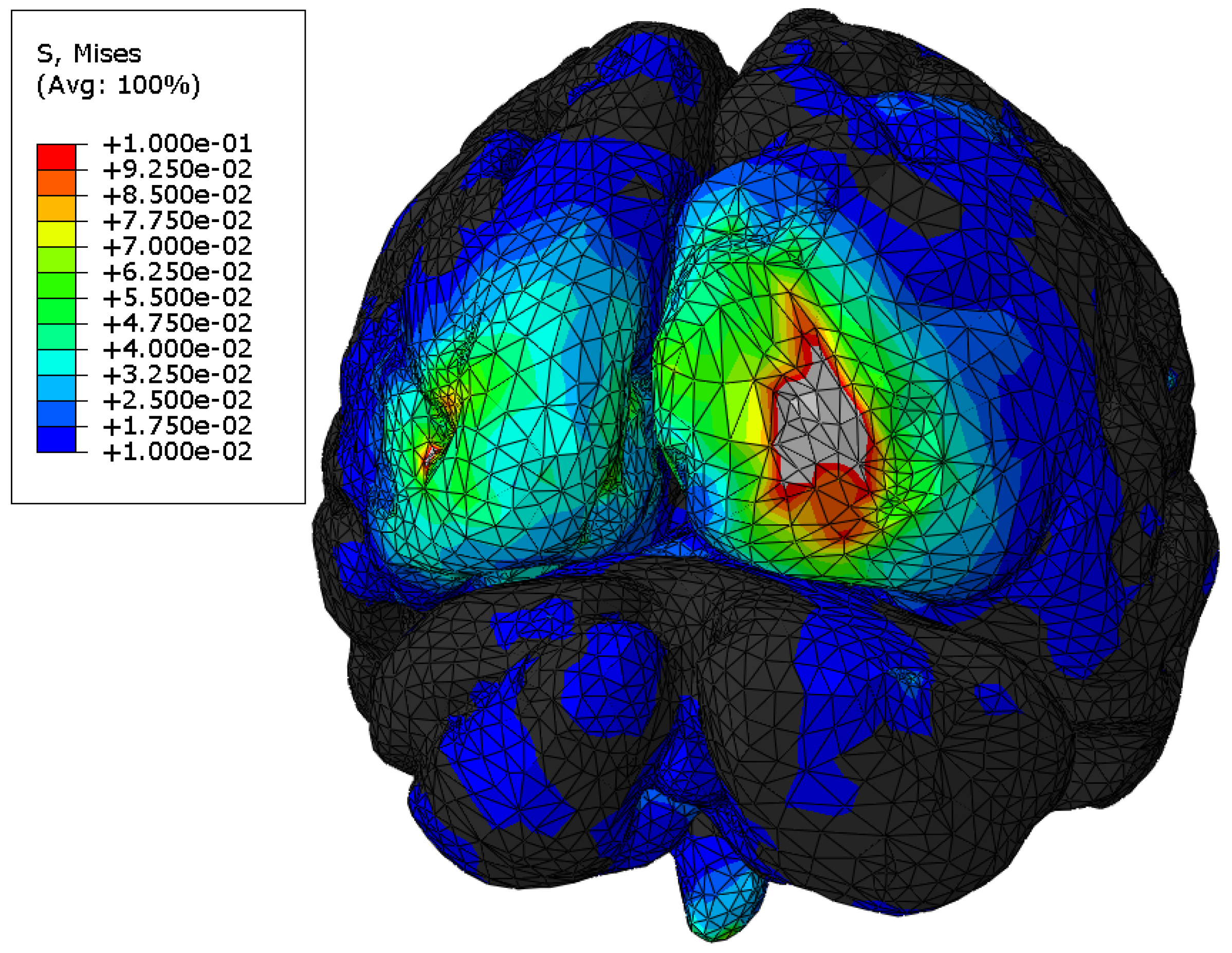
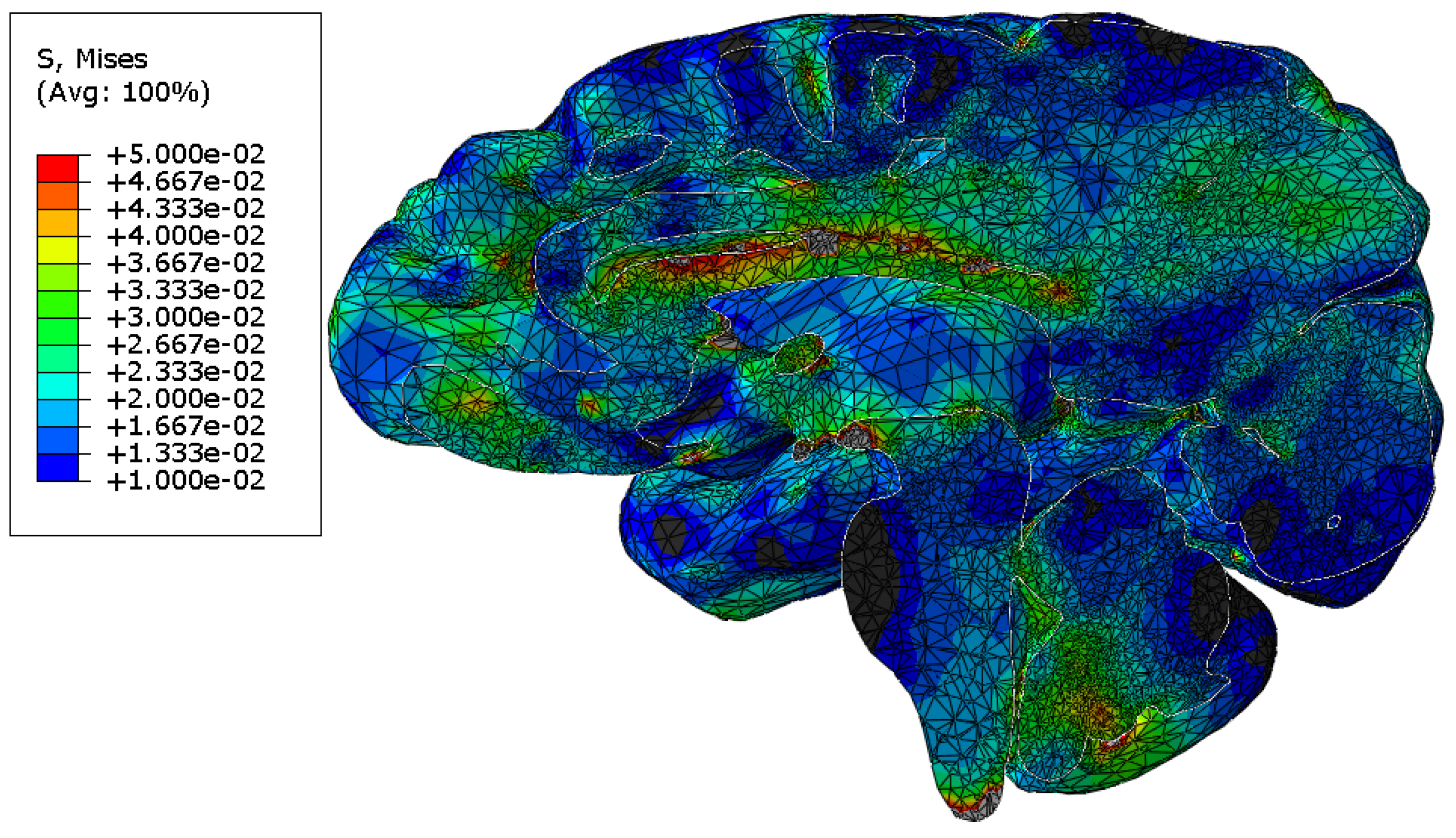
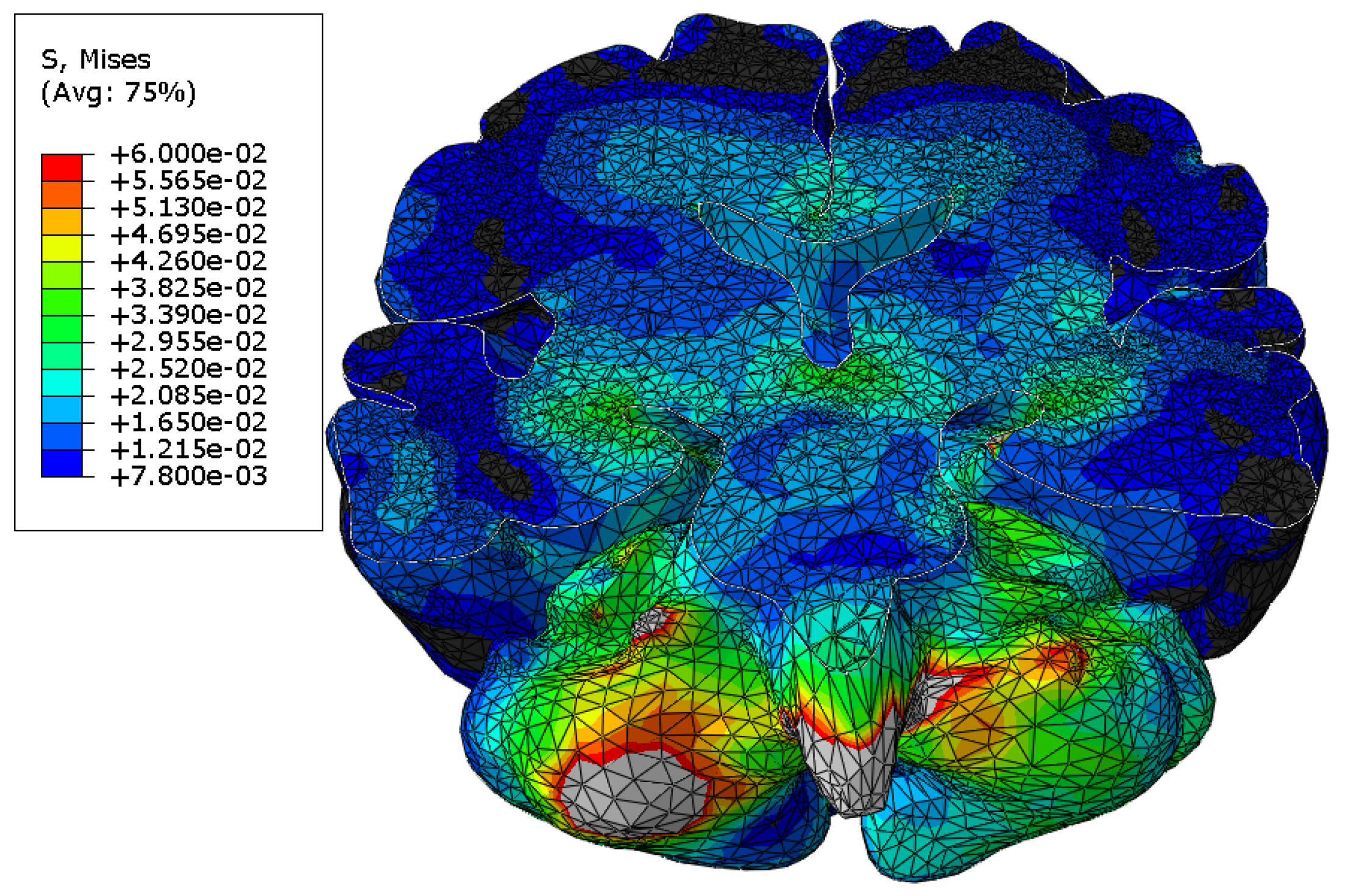
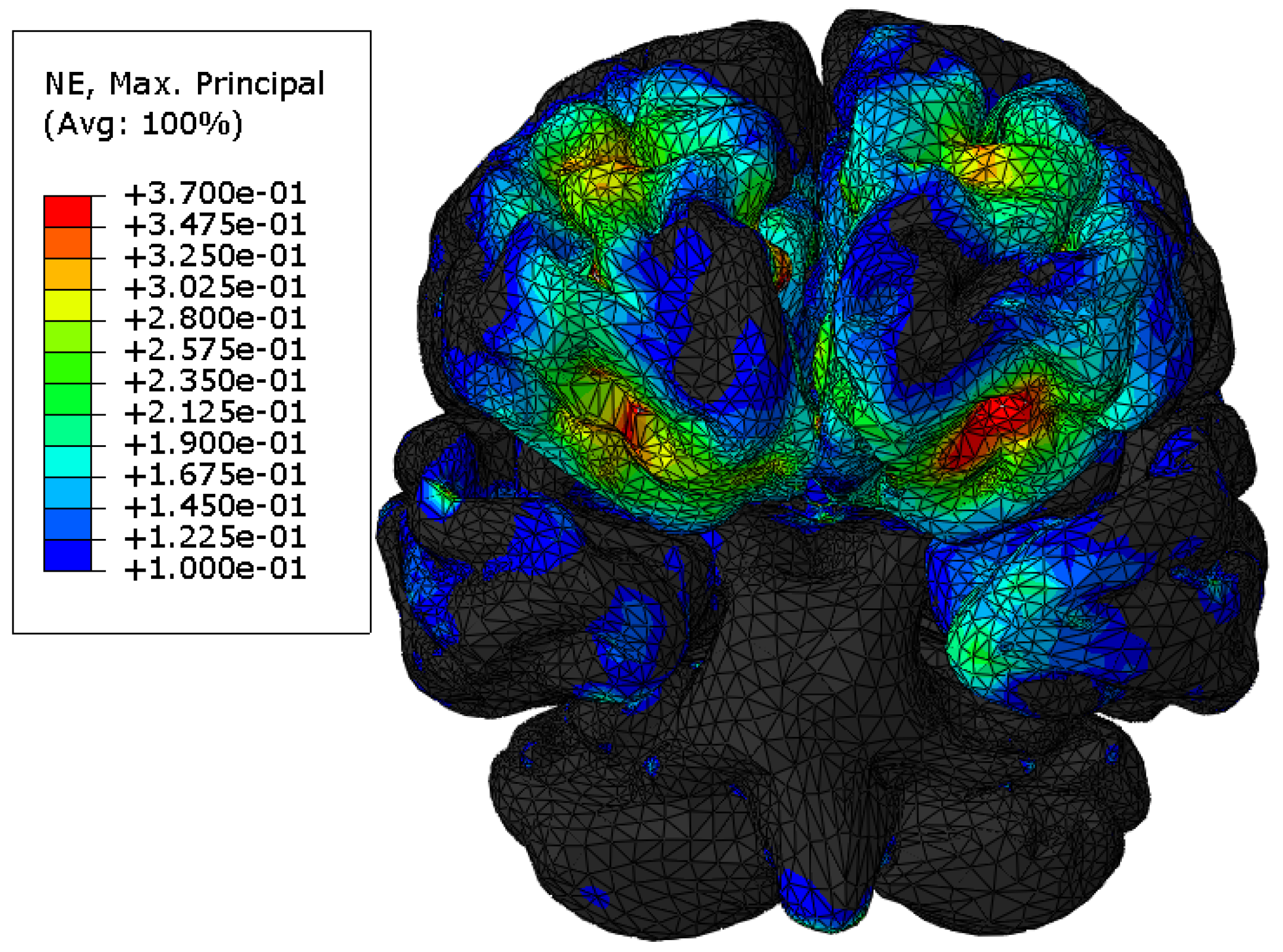
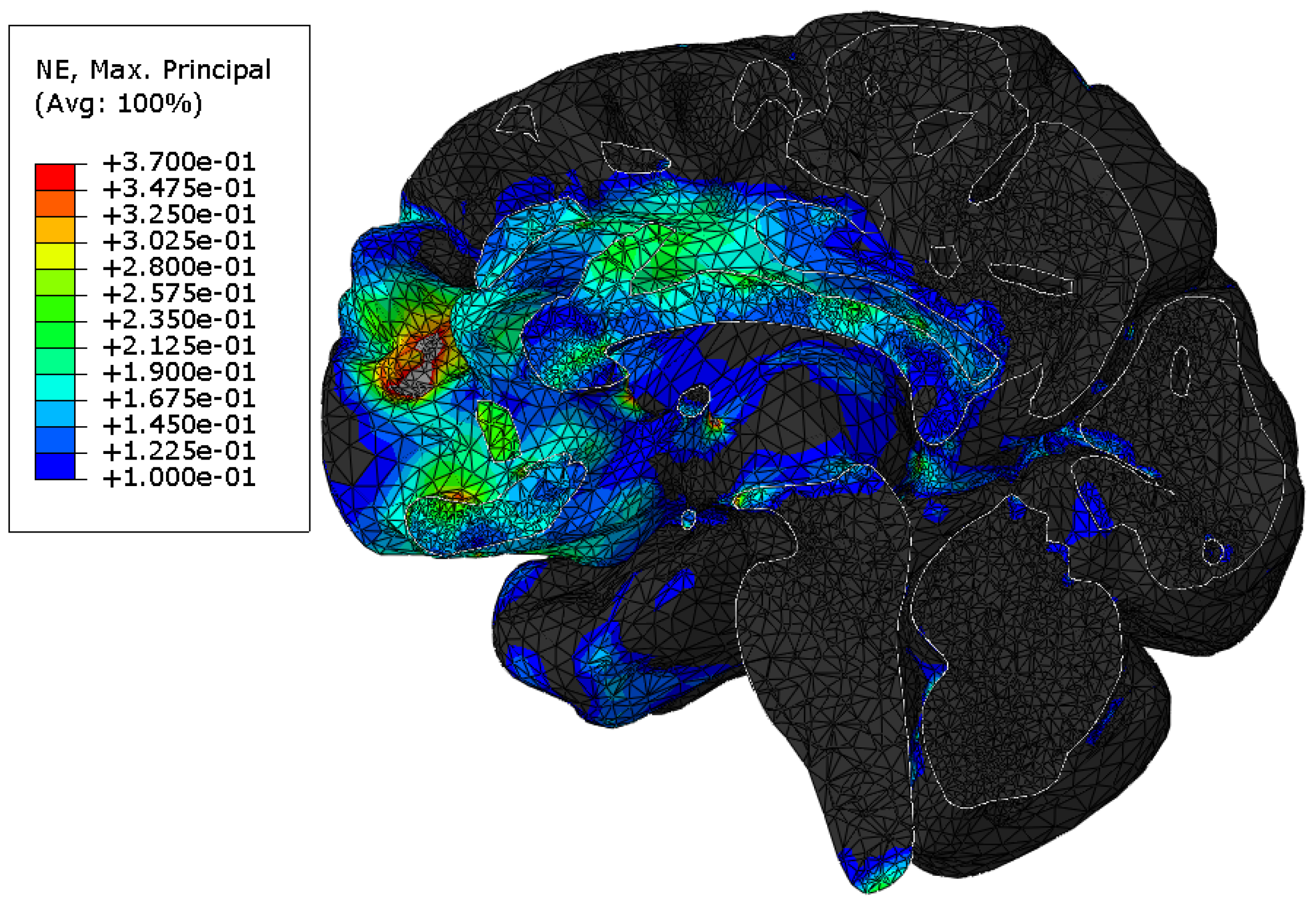
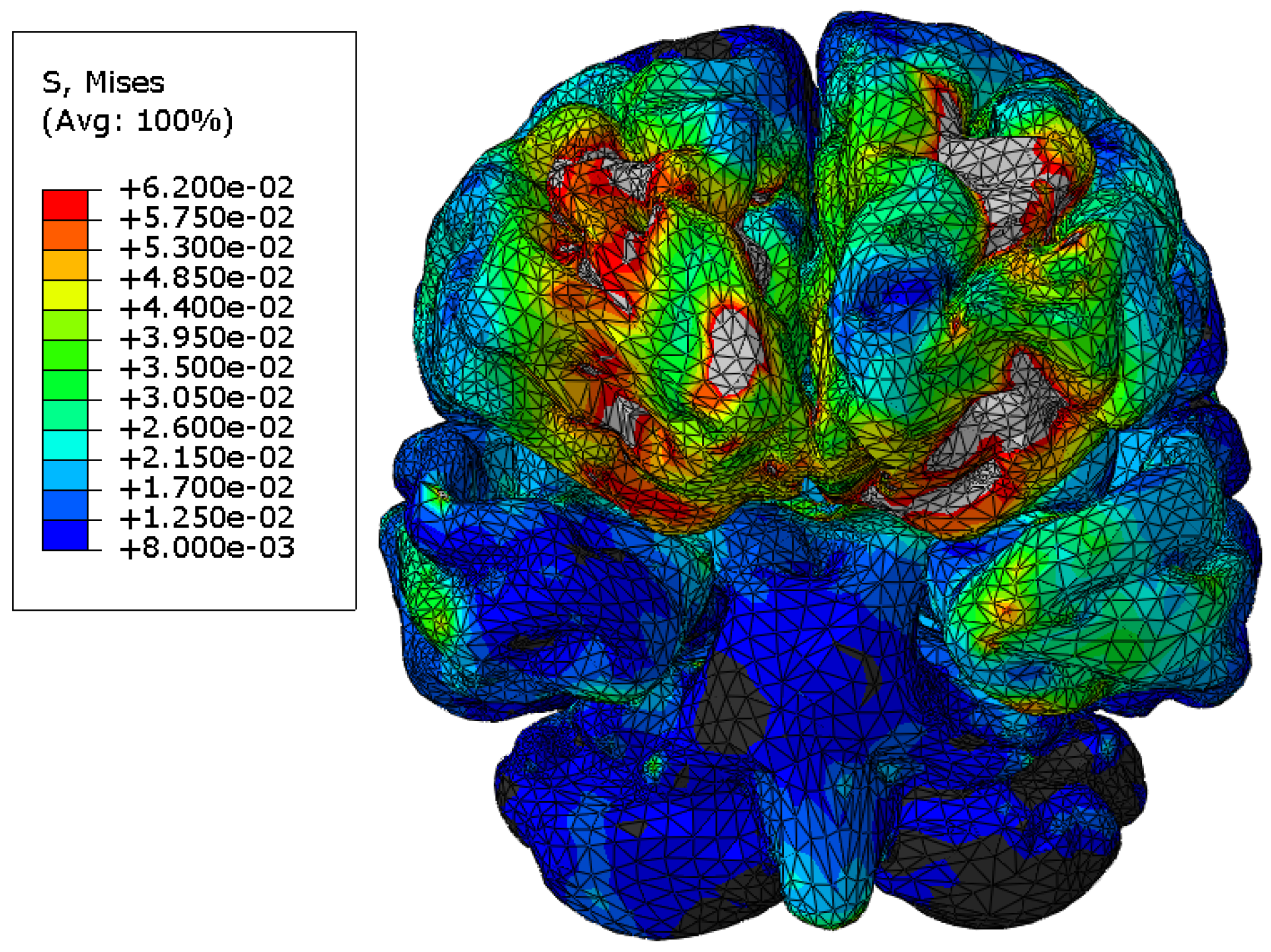
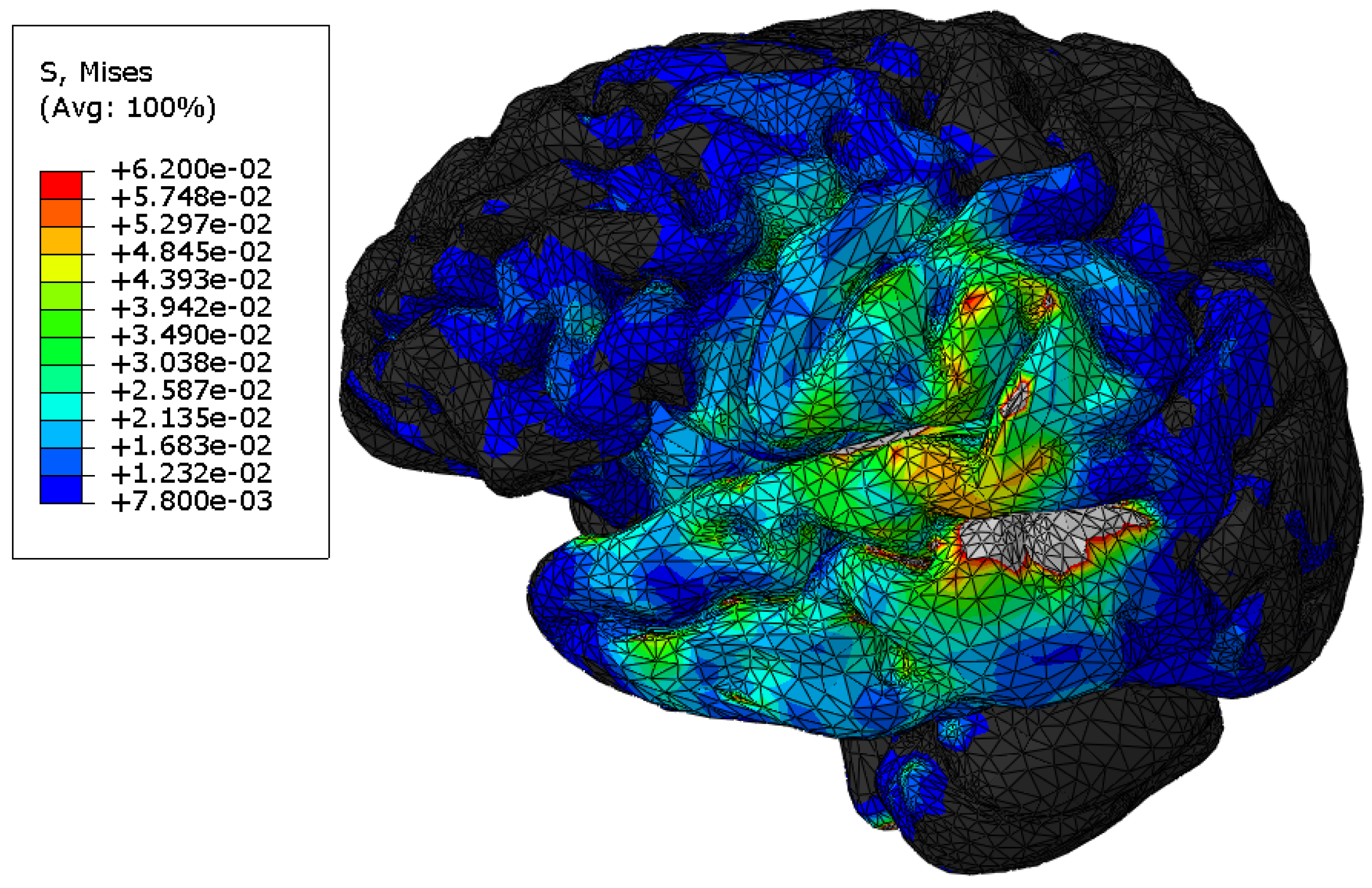
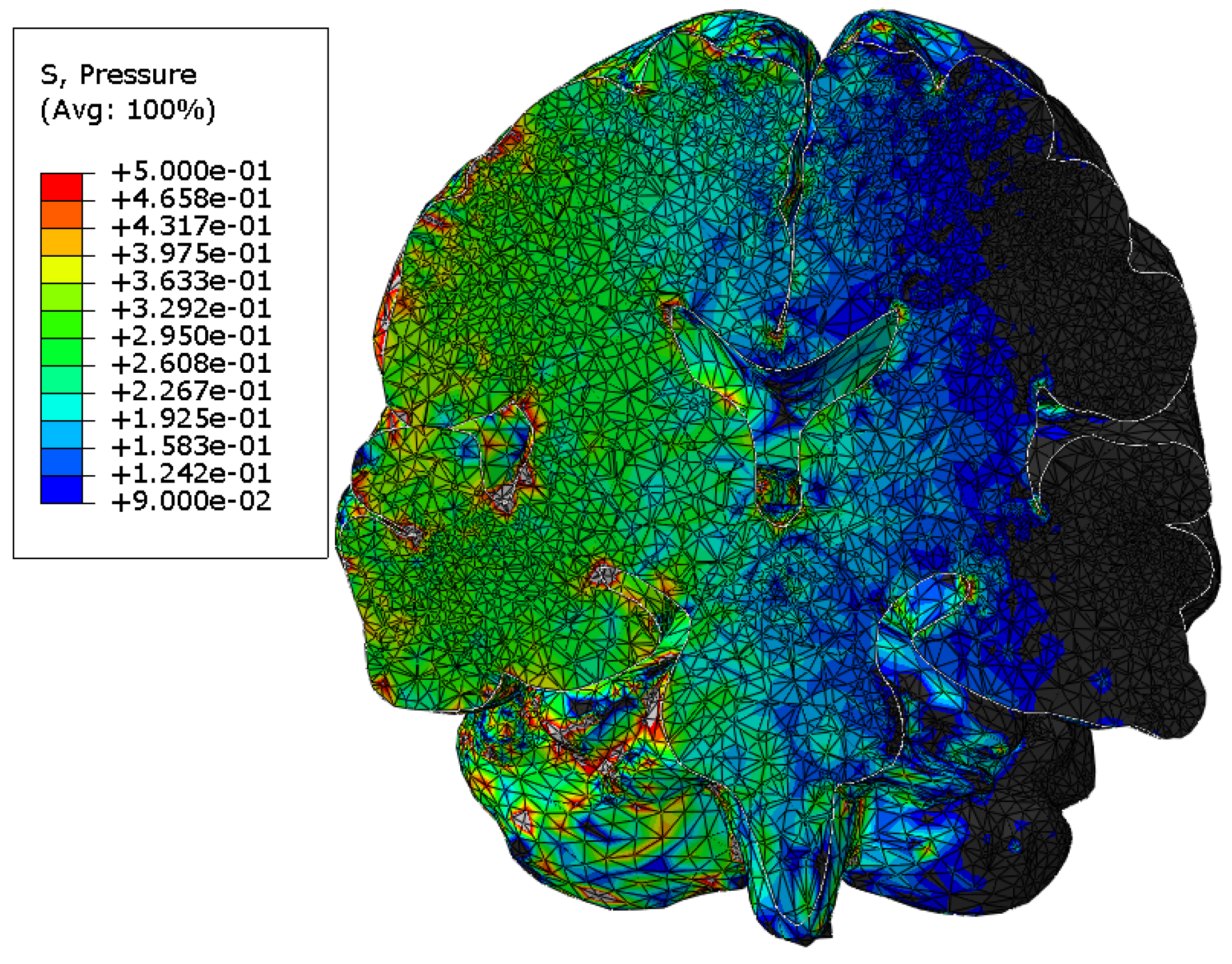
| Mass [kg] | [kg cm2] | [kg cm2] | [kg cm2] |
|---|---|---|---|
| 5.6 | 370 | 440 | 300 |
| Part | Element Type (Abaqus) | N. of Elements | N. of Nodes |
|---|---|---|---|
| Shell | Four-node linear shell (S4) | 11,954 | 12,310 |
| Liner | Four-node linear tetrahedron (C3D4) | 109,872 | 24,545 |
| Headform | Rigid quadrangular shell (R3D4) | 1346 | 1348 |
| Anvil | 4 | 9 |
| [kg/m3] | [MPa] | [MPa−1] | [s] | [s] | |||
|---|---|---|---|---|---|---|---|
| 1040 | 0.012 | 5.0507 | 0.04 | 0.5837 | 0.2387 | 0.02571 | 0.02570 |
| [kg/m3] | [MPa] | [MPa] | [MPa−1] |
|---|---|---|---|
| 1000 | 0.9 | 1 | 0.9 |
© 2020 by the authors. Licensee MDPI, Basel, Switzerland. This article is an open access article distributed under the terms and conditions of the Creative Commons Attribution (CC BY) license (http://creativecommons.org/licenses/by/4.0/).
Share and Cite
Fernandes, F.A.O.; Alves de Sousa, R.J.; Ptak, M.; Wilhelm, J. Certified Motorcycle Helmets: Computational Evaluation of the Efficacy of Standard Requirements with Finite Element Models. Math. Comput. Appl. 2020, 25, 12. https://doi.org/10.3390/mca25010012
Fernandes FAO, Alves de Sousa RJ, Ptak M, Wilhelm J. Certified Motorcycle Helmets: Computational Evaluation of the Efficacy of Standard Requirements with Finite Element Models. Mathematical and Computational Applications. 2020; 25(1):12. https://doi.org/10.3390/mca25010012
Chicago/Turabian StyleFernandes, Fábio A. O., Ricardo J. Alves de Sousa, Mariusz Ptak, and Johannes Wilhelm. 2020. "Certified Motorcycle Helmets: Computational Evaluation of the Efficacy of Standard Requirements with Finite Element Models" Mathematical and Computational Applications 25, no. 1: 12. https://doi.org/10.3390/mca25010012
APA StyleFernandes, F. A. O., Alves de Sousa, R. J., Ptak, M., & Wilhelm, J. (2020). Certified Motorcycle Helmets: Computational Evaluation of the Efficacy of Standard Requirements with Finite Element Models. Mathematical and Computational Applications, 25(1), 12. https://doi.org/10.3390/mca25010012








